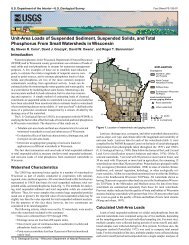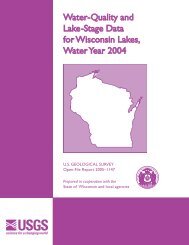The Effects of Large-Scale Pumping and Diversion on ... - Wisconsin
The Effects of Large-Scale Pumping and Diversion on ... - Wisconsin
The Effects of Large-Scale Pumping and Diversion on ... - Wisconsin
You also want an ePaper? Increase the reach of your titles
YUMPU automatically turns print PDFs into web optimized ePapers that Google loves.
county streams are <strong>on</strong>ly slightly affected.<br />
Scenario 2 indicates that the wells would<br />
capture water that normally would flow to<br />
area wetl<str<strong>on</strong>g>and</str<strong>on</strong>g>s <str<strong>on</strong>g>and</str<strong>on</strong>g> streams rather than removing<br />
water from the lakes. This result is<br />
dem<strong>on</strong>strated by the increased drawdown<br />
from 1992 c<strong>on</strong>diti<strong>on</strong>s for scenario 2 (fig.<br />
4b). <str<strong>on</strong>g>The</str<strong>on</strong>g> additi<strong>on</strong>al drawdown in the water<br />
table for scenario 2 is much greater than<br />
scenario 1, indicating that scenario 2 would<br />
have the greatest adverse effect <strong>on</strong> wetl<str<strong>on</strong>g>and</str<strong>on</strong>g>s<br />
<str<strong>on</strong>g>and</str<strong>on</strong>g> streams in the county. <str<strong>on</strong>g>The</str<strong>on</strong>g>se<br />
scenarios are for illustrative purposes <strong>on</strong>ly<br />
<str<strong>on</strong>g>and</str<strong>on</strong>g> do not account for the feasibility (ec<strong>on</strong>omic,<br />
political, or other c<strong>on</strong>siderati<strong>on</strong>s)<br />
<str<strong>on</strong>g>of</str<strong>on</strong>g> implementing any particular pumping<br />
strategy. Such c<strong>on</strong>siderati<strong>on</strong>s would have<br />
to also be taken into account to fully assess<br />
the practicability <str<strong>on</strong>g>of</str<strong>on</strong>g> different strategies.<br />
References<br />
Bradbury, K.R., Swans<strong>on</strong>, S.K., Krohelski, J.T.,<br />
<str<strong>on</strong>g>and</str<strong>on</strong>g> Fritz, A.K., 1999, Hydrogeology <str<strong>on</strong>g>of</str<strong>on</strong>g> Dane<br />
County, Wisc<strong>on</strong>sin: Wisc<strong>on</strong>sin Geological <str<strong>on</strong>g>and</str<strong>on</strong>g><br />
Natural History Survey Open-File Report 1999-<br />
04, 66 p.<br />
Dane County Regi<strong>on</strong>al Planning Commissi<strong>on</strong><br />
(DCRPC), 1997, <str<strong>on</strong>g>The</str<strong>on</strong>g> 1997 modeling <str<strong>on</strong>g>and</str<strong>on</strong>g> management<br />
program: DCRPC, Madis<strong>on</strong>, Wis., 24<br />
p.<br />
Krohelski, J.T., Bradbury, K.R., Hunt, R.J. <str<strong>on</strong>g>and</str<strong>on</strong>g>,<br />
Swans<strong>on</strong>, S.K., 2000, Numerical simulati<strong>on</strong> <str<strong>on</strong>g>of</str<strong>on</strong>g><br />
groundwater flow in Dane County, Wisc<strong>on</strong>sin:<br />
Wisc<strong>on</strong>sin Geological <str<strong>on</strong>g>and</str<strong>on</strong>g> Natural History<br />
Survey Bulletin 98, 31p.<br />
Krohelski, J.T., Lin, Y., Rose, W.J., <str<strong>on</strong>g>and</str<strong>on</strong>g> Hunt R.J.,<br />
2001, Simulati<strong>on</strong> <str<strong>on</strong>g>of</str<strong>on</strong>g> Fish, Mud <str<strong>on</strong>g>and</str<strong>on</strong>g> Crystal<br />
Lakes <str<strong>on</strong>g>and</str<strong>on</strong>g> the shallow ground water system <str<strong>on</strong>g>of</str<strong>on</strong>g><br />
northwestern Dane County, Wisc<strong>on</strong>sin: U.S.<br />
Geological Survey Water-Resources Investigati<strong>on</strong>s<br />
Report (in review)<br />
Hunt, R.J., <str<strong>on</strong>g>and</str<strong>on</strong>g> Steuer, J.J. 2000, Simulati<strong>on</strong> <str<strong>on</strong>g>of</str<strong>on</strong>g> the<br />
recharge area for Frederick Springs, Dane<br />
County, Wisc<strong>on</strong>sin: U.S. Geological Survey<br />
Water-Resources Investigati<strong>on</strong>s Report 00-<br />
4172, 33 p.<br />
Hunt, R.J., Steuer, J.J., Mansor, M.T.C., <str<strong>on</strong>g>and</str<strong>on</strong>g><br />
Bullen, T.D., 2001, Delineating a recharge area<br />
for a spring using numerical modeling, M<strong>on</strong>te<br />
Carlo Techniques, <str<strong>on</strong>g>and</str<strong>on</strong>g> geochemical investigati<strong>on</strong>:<br />
Ground Water v. 39, no. 5, p. 702-712.<br />
McD<strong>on</strong>ald, M.G., <str<strong>on</strong>g>and</str<strong>on</strong>g> Harbaugh, A.W., 1988, A<br />
modular three-dimensi<strong>on</strong>al finite-difference<br />
ground-water flow model: U.S. Geological Survey<br />
Techniques <str<strong>on</strong>g>of</str<strong>on</strong>g> Water-Resources Investigati<strong>on</strong>s,<br />
book 6, chap. A1, 586 p.<br />
Steuer, J.J., <str<strong>on</strong>g>and</str<strong>on</strong>g> Hunt, R.J., 2001, Use <str<strong>on</strong>g>of</str<strong>on</strong>g> a watershed-modeling approach to assess<br />
hydrologic effects <str<strong>on</strong>g>of</str<strong>on</strong>g> urbanizati<strong>on</strong>, North Fork Pheasant Branch Basin near Middlet<strong>on</strong>,<br />
Wisc<strong>on</strong>sin: U.S. Geological Survey Water-Resources Investigati<strong>on</strong>s Report 01-<br />
4113, 49 p.<br />
Informati<strong>on</strong><br />
For informati<strong>on</strong> <strong>on</strong> this study or <strong>on</strong> other USGS programs in Wisc<strong>on</strong>sin, c<strong>on</strong>tact:<br />
District Chief<br />
U.S. Geological Survey<br />
8505 Research Way<br />
Middlet<strong>on</strong>, WI 53562<br />
(608) 828-9901<br />
http://wi.water.usgs.gov/<br />
A<br />
B<br />
0 5 10 MILES<br />
0 5 10 KILOMETERS<br />
Figures 4a <str<strong>on</strong>g>and</str<strong>on</strong>g> 4b. <str<strong>on</strong>g>The</str<strong>on</strong>g> model can be used to simulate changes in the hydrologic system for a selected<br />
management scenario. In this example, the Madis<strong>on</strong> municipal wells are divided into an inner ring (red dots)<br />
<str<strong>on</strong>g>and</str<strong>on</strong>g> outer ring (yellow dots). In 4a (scenario 1) the inner ring pumps 75 percent <str<strong>on</strong>g>of</str<strong>on</strong>g> the total water pumped <str<strong>on</strong>g>and</str<strong>on</strong>g><br />
the outer ring pumps the remaining 25 percent; in 4b (scenario 2) the outer ring pumps 75 percent <str<strong>on</strong>g>of</str<strong>on</strong>g> the total<br />
water pumped <str<strong>on</strong>g>and</str<strong>on</strong>g> the inner ring pumps the remaining 25 percent. As shown, if the outer rings are required to<br />
supply 75 percent <str<strong>on</strong>g>of</str<strong>on</strong>g> the total water, there will be increased drawdown in the areas near the wells. <str<strong>on</strong>g>The</str<strong>on</strong>g>re is<br />
much less drawdown from pumping the inner ring <str<strong>on</strong>g>of</str<strong>on</strong>g> wells because the water primarily is derived from the<br />
Yahara lakes (a relatively large source <str<strong>on</strong>g>of</str<strong>on</strong>g> water).<br />
How this regi<strong>on</strong>al model has been applied to smaller site investigati<strong>on</strong>s<br />
<str<strong>on</strong>g>The</str<strong>on</strong>g> Dane County ground-water-flow model is suitable for use as a tool for regi<strong>on</strong>al water management,<br />
but because <str<strong>on</strong>g>of</str<strong>on</strong>g> its regi<strong>on</strong>al focus, the model should not be used for site-specific simulati<strong>on</strong>. However, the<br />
model provides a valuable framework within which site-specific studies can be carried out. <str<strong>on</strong>g>The</str<strong>on</strong>g> following<br />
are examples <str<strong>on</strong>g>of</str<strong>on</strong>g> <strong>on</strong>going site-specific studies that have made use <str<strong>on</strong>g>of</str<strong>on</strong>g> the Dane County model.<br />
Pheasant Branch Watershed – <str<strong>on</strong>g>The</str<strong>on</strong>g> Dane County model was used for a smaller-scale ground-water/<br />
surface-water modeling study d<strong>on</strong>e by the U.S. Geological Survey, in cooperati<strong>on</strong> with the City <str<strong>on</strong>g>of</str<strong>on</strong>g><br />
Middlet<strong>on</strong> <str<strong>on</strong>g>and</str<strong>on</strong>g> the Wisc<strong>on</strong>sin Department <str<strong>on</strong>g>of</str<strong>on</strong>g> Natural Resources. <str<strong>on</strong>g>The</str<strong>on</strong>g> study focused <strong>on</strong> the effects <str<strong>on</strong>g>of</str<strong>on</strong>g><br />
urbanizati<strong>on</strong> <strong>on</strong> streamflows <str<strong>on</strong>g>and</str<strong>on</strong>g> spring flows (Hunt <str<strong>on</strong>g>and</str<strong>on</strong>g> Steuer, 2000; Hunt <str<strong>on</strong>g>and</str<strong>on</strong>g> others, 2001; Steuer <str<strong>on</strong>g>and</str<strong>on</strong>g><br />
Hunt, 2001), <str<strong>on</strong>g>and</str<strong>on</strong>g> the models are now part <str<strong>on</strong>g>of</str<strong>on</strong>g> a large watershed-scale project c<strong>on</strong>ducted by the Wisc<strong>on</strong>sin<br />
Department <str<strong>on</strong>g>of</str<strong>on</strong>g> Natural Resources, University <str<strong>on</strong>g>of</str<strong>on</strong>g> Wisc<strong>on</strong>sin – Madis<strong>on</strong>, Wisc<strong>on</strong>sin Geological <str<strong>on</strong>g>and</str<strong>on</strong>g> Natural<br />
History Survey, <str<strong>on</strong>g>and</str<strong>on</strong>g> U.S. Geological Survey.<br />
Nine Springs Watershed – <str<strong>on</strong>g>The</str<strong>on</strong>g> Nine Springs watershed, located just south <str<strong>on</strong>g>of</str<strong>on</strong>g> the City <str<strong>on</strong>g>of</str<strong>on</strong>g> Madis<strong>on</strong> (fig.<br />
1a), c<strong>on</strong>tains an unusually large c<strong>on</strong>centrati<strong>on</strong> <str<strong>on</strong>g>of</str<strong>on</strong>g> cold-water springs <str<strong>on</strong>g>and</str<strong>on</strong>g> associated wetl<str<strong>on</strong>g>and</str<strong>on</strong>g>s. <str<strong>on</strong>g>The</str<strong>on</strong>g> Dane<br />
County model was used as a starting point for the c<strong>on</strong>structi<strong>on</strong> <str<strong>on</strong>g>of</str<strong>on</strong>g> a detailed inset model to investigate these<br />
springs <str<strong>on</strong>g>and</str<strong>on</strong>g> to determine the effects nearby l<str<strong>on</strong>g>and</str<strong>on</strong>g>-use changes may have <strong>on</strong> the springs <str<strong>on</strong>g>and</str<strong>on</strong>g> wetl<str<strong>on</strong>g>and</str<strong>on</strong>g>s<br />
(Swans<strong>on</strong>, 2001). Model simulati<strong>on</strong>s helped quantify anticipated reducti<strong>on</strong>s in spring discharge resulting<br />
from nearby ground-water withdrawals <str<strong>on</strong>g>and</str<strong>on</strong>g> simulated the l<str<strong>on</strong>g>and</str<strong>on</strong>g>-surface area c<strong>on</strong>tributing recharge to the<br />
springs. This informati<strong>on</strong> is critical for making l<str<strong>on</strong>g>and</str<strong>on</strong>g>-use decisi<strong>on</strong>s to protect the quality <str<strong>on</strong>g>and</str<strong>on</strong>g> quantity <str<strong>on</strong>g>of</str<strong>on</strong>g><br />
spring discharge.<br />
Fish <str<strong>on</strong>g>and</str<strong>on</strong>g> Crystal Lakes – Elevati<strong>on</strong> <str<strong>on</strong>g>of</str<strong>on</strong>g> the stage <str<strong>on</strong>g>of</str<strong>on</strong>g> Fish <str<strong>on</strong>g>and</str<strong>on</strong>g> Crystal Lakes, located in northwestern Dane<br />
County (fig. 1a), has increased 9 feet since 1966 <str<strong>on</strong>g>and</str<strong>on</strong>g> caused flooding <str<strong>on</strong>g>of</str<strong>on</strong>g> some near-shore residences. By<br />
using the Dane County model as a starting point, a new U.S. Geological Survey computer program that<br />
simulates lakes was coupled to a model <str<strong>on</strong>g>of</str<strong>on</strong>g> the ground-water system <str<strong>on</strong>g>and</str<strong>on</strong>g> was used to determine that<br />
increasing ground-water recharge was resp<strong>on</strong>sible for the lake-stage increase. <str<strong>on</strong>g>The</str<strong>on</strong>g> model was then used to<br />
simulate how pumping from Fish Lake would lower the stage <str<strong>on</strong>g>of</str<strong>on</strong>g> both lakes <str<strong>on</strong>g>and</str<strong>on</strong>g> how the lake stages would<br />
recover when pumping was stopped (Krohelski <str<strong>on</strong>g>and</str<strong>on</strong>g> others, 2001).<br />
Authors: R<str<strong>on</strong>g>and</str<strong>on</strong>g>all J. Hunt, Kenneth R. Bradbury, <str<strong>on</strong>g>and</str<strong>on</strong>g><br />
James T. Krohelski<br />
Printed <strong>on</strong> recycled paper<br />
EXPLANATION<br />
Madis<strong>on</strong> municipal well<br />
Other municipal well<br />
Drawdown,<br />
in feet<br />
Swans<strong>on</strong>, S.K. 2001. Hydrogeologic c<strong>on</strong>trols <strong>on</strong> spring flow near Madis<strong>on</strong>, Wisc<strong>on</strong>sin:<br />
Unpublished Ph.D. dissertati<strong>on</strong>, Dept. <str<strong>on</strong>g>of</str<strong>on</strong>g> Geology <str<strong>on</strong>g>and</str<strong>on</strong>g> Geophysics, University <str<strong>on</strong>g>of</str<strong>on</strong>g><br />
Wisc<strong>on</strong>sin–Madis<strong>on</strong>, 436 p.<br />
10<br />
15<br />
20<br />
25<br />
30<br />
35<br />
40<br />
45








